IR-4 publishes four crop safety and efficacy summaries
The IR-4 Environmental Horticulture Program published its botrytis and algal leaf spot efficacy summaries and cyflumetofen and picarbutrazox crop safety summaries this week. This follows the publication of crop safety summaries of two herbicides—iron HEDTA (Fiesta) and oxyfluorfen + prodiamine (Biathlon)—in January.
Most of you are familiar with, or at least have heard of, the IR-4 Project, right? The IR-4 Project is a collaborative project that facilitates registrations of conventional pesticides and biopesticides for food and non-food specialty crops (ornamentals, turf, vegetables, herbs, spices, fruits and nuts). The IR-4 Project, working with researchers like me, evaluates the crop safety and efficacy of new products and products that had been registered for other commodities, and helps obtain registrations of these products for, or expand the uses on specialty crops.
These crop safety and efficacy summaries are like gold mines to researchers and extension specialists like me. I run several insecticide efficacy trials each year, but I can't test all products and I don't evaluate fungicides or conduct crop safety trials. If I want to find out what my colleagues had found out about the crop safety of, say, Insimmo (acibenzolar) plant defense stimulator, I’ll go to the summary for that product on the IR-4 Environmental Horticulture Program’s website.
These summaries are accessible to all by clicking here. So, you can see for yourself the research-based efficacy or crop safety data of the pesticides you are interested in.
I’ll attempt to summarize the summaries. Please note that IR-4 didn’t test every product and every plant species under the sun, so some of your favorite products or plant species may not be mentioned in the summaries. If you want to see something tested, fill out the Grower Needs Survey or the Specific Project Request by clicking here. The IR-4 Project staff, researchers and manufacturers will gather for a workshop to discuss research needs for the next two years this coming September.
Fifty-two active ingredients were evaluated against botrytis between 1998 and 2018. The majority of the trials were conducted against Botrytis cinerea (on 13 plant taxa), but some were conducted against B. elliptica, B. paeoniae and B. tulipae. Based on the data, Compass (fluazinam), Daconil (chlorothalonil), Decree (fenhexamid), Heritage (azoxystrobin), Insignia Intrinsic (pyraclostrobin), Pageant Intrinsic (boscalid + pyraclostrobin) and Palladium (cyprodinil + fludioxanil) provided excellent efficacy (> 95% reduction in disease severity or infection), whereas Chipco 26019 (iprodione) and Veranda O (polyoxin D zinc salt) provided good efficacy (80-90% reduction). There aren’t enough data to make conclusions on some of the newest fungicides, such as EcoSwing (Swinglea glutinosa), PreStop (Gliocladium catenulatum strain J1466), Regalia (extract of Reynoutria sachalinensis), Torque (tebuconazole), Tourney (metconazole) and Trinity (triticonazole).
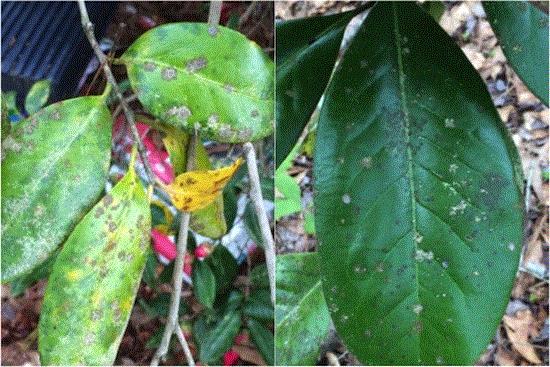
Algal leaf spots plagued my camellias (left) and southern magnolias (right, with some lichen mixed in). I don't do anything to control them because they don't bother me. Check out IR-4's algal leaf spot efficacy summary to find a solution for your algal leaf spot problem.
Do y’all have to deal with algal leaf spot? Algal leaf spot caused by Cephaleuros virescens is a persistent problem on southern magnolias and camellias in the southeastern U.S. Ten active ingredients were evaluated against algal leaf spot on southern magnolias in two trials in 2015. The trials found that all tested fungicides reduced algal leaf spot, but KleenGrow (dodecyl dimethyl ammonium chloride), Mural (azoxystrobin + benzovindiflupyr) and COC DF (copper oxychloride) stood out as the most effective. Remember that there were only two trials, so take the conclusions with a grain of salt. I suggest that you try out the products and compare how you like their efficacies.
Cyflumetofen (Sultan) is a miticide with excellent efficacy against many spider mite species and compatible with many predatory mite species. The IR-4 Project conducted 92 trials on 25 plant species to examine the phytotoxicity of cyflumetofen on plant species that aren’t listed on the label. Only impatiens (Impatiens walleriana) showed significant injury or growth reduction in two of three trials.
Picarbutrazox is a new fungicide of a novel mode of action from Nippon Soda (and its subsidiary, Nisso America). This new fungicide has efficacy against several oomycete diseases, including pythium and phytophthora. Syngenta licensed the new fungicide from Nippon Soda in early 2018 (for seed treatment only), but there is currently no registered product available for the ornamentals market. The IR-4 Projects conducted 27 trials on 12 plant taxa, and found no or minimal injury on all tested plant taxa.

New and improved USA-NPN Pheno Forecast Maps
The USA National Phenology Network (USA-NPN) has released improved Pheno Forecast Maps for 12 insect species, including some of our most dreaded pests. These species are apple maggot, Asian longhorned beetle, bagworm, bronze birch borer, eastern tent caterpillar, emerald ash borer, gypsy moth, hemlock woolly adelgid, lilac borer, magnolia scale, pine needle scale and winter moth.
The Pheno Forecast Maps are generated using accumulated growing degree-days and known degree-day models of the insect pests. You can generate predictive maps for current day or 6-day forecasts. For example, based on the Pheno Forecast Map for eastern tent caterpillar, this pest has already ended its emergence (or egg hatch) in my area (colored dark gray in the map below). In fact, the eastern tent caterpillars in my back yard are wandering and looking for a pupation site. But, caterpillars are emerging in a large swath from Virginia to Kansas (colored yellow in the map) and caterpillars are predicted to emerge in the next 1-2 weeks in areas stretching from Philadelphia, Pennsylvania, to Indianapolis, Indiana (colored teal in the map). Folks can use these maps to predict when a selected insect species will emerge and time their treatment accordingly. I thought this is a pretty useful and fun tool for the 12 insect species included in the models.
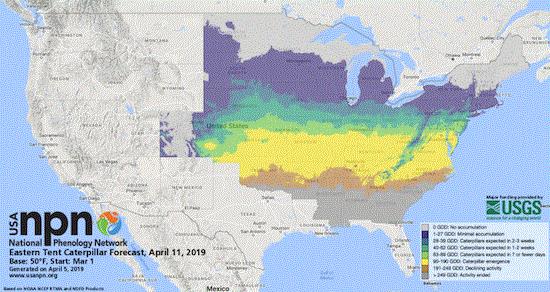
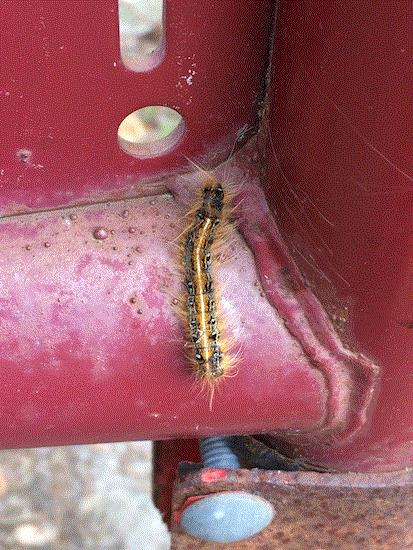
In addition to the forecast map, you can also get basic biological information about a certain insect species and the degree-day model used for the forecast.
You can also generate accumulated growing degree-day maps. The map below tells me that those of us in the southeastern corner of the U.S. have already experienced quite a bit of heat (the high today is going to be 74F).
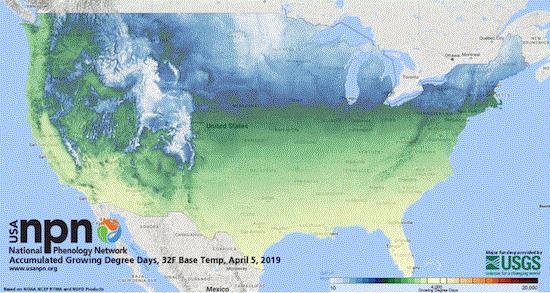
The USA-NPN is a network of researchers, educators, pest and plant managers and citizen scientists that collect plant and animal phenological observations throughout the country. The network is coordinated from the National Coordinating Office at the University of Arizona.
How accurate are those maps in predicting insect activity in your area? You can help make them better by contributing your observational data to the organization’s Nature’s Notebook. The more data the USA-NPN can incorporate into its models, the better the forecasts can be. Visit USA-NPN website to sign up.

UF Greenhouse Training online course is back
University of Florida will once again offer its award-winning Greenhouse Training online course in 2019. The series starts on May 27 with Greenhouse 101. The course is built on modules, including Greenhouse 101, Nutrient Management (introductory and advanced), Costing and Profitability, Disease Management, Weed Management, and Irrigation Water Quality and Treatment. Each module has different start and end dates, and is available in English and Spanish.
Go to the training course website to find out more about the training course and to register.
Webinars on suckers
Watch out! Some shameless self-promotion is coming your way.
I’ll be presenting a webinar for the GrowerTalks webinar series at 1:00 PM EST on April 24. I’ll focus on aphids and whiteflies, and talk about my experience with BASF’s new product—Ventigra.
Also, my friends Karla Addesso of Tennessee State University and Aaron Palmateer of Bayer, will talk about piercing and sucking insects on their webinar on May 16. Karla and Aaron will talk about aphids, scales and other sucking insects. They will also discuss conventional management approaches and neonicotinoid alternatives, such as Altus.
You’ll learn some of the newest development and research on these suckers during the two webinars. Join us by registering for GrowerTalks webinars HERE. I guarantee you can use the information to better your life.
Can I grill that on a cedar plank?
My bourbon-and-cigar buddy and fellow Clemson University extension agent, TJ Savereno, sent me a picture of a salmonfly. TJ took the picture on his porch last week.
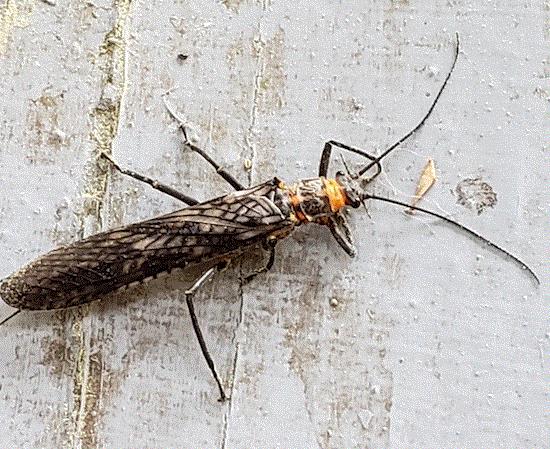
It ain’t a salmon, and it ain’t a fly. Salmonfly is a general name for a family of stoneflies. I took a class in Aquatic Entomology, but I’m nowhere near good enough to identify the species based on a picture.
Salmonfly larvae are aquatic, and the adults live only a short time and survive only on fat saved up during its larval stage. Both larvae and adults are favorites of fish, especially trout. Some fishermen tie flies that are wonderful and colorful imitations of salmonflies; they blow my mind!
I also found a bumper crop of cedar-apple rust in my back yard. These gelatinous horns are coming out of the branches and trunks after our latest spring rain. They’re awesome, and gross at the same time. If you want to know more about cedar-apple rust, revisit my newsletter from June 7, 2018.
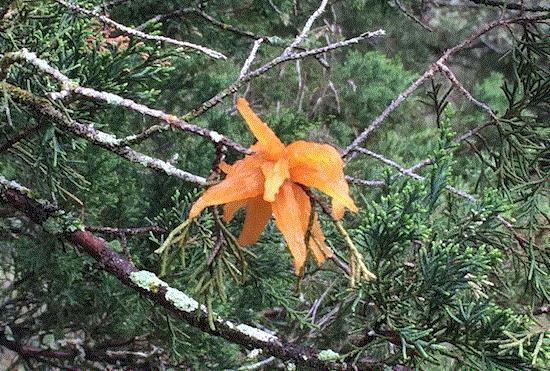
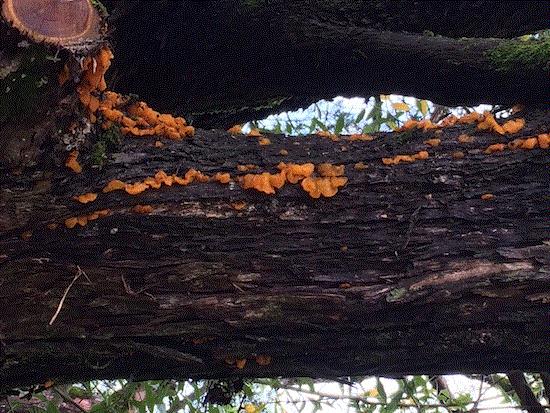
See y'all next time!

JC Chong
Associate Professor of Entomology at Clemson University
This e-mail received by 24,985 subscribers like you!
If you're interested in advertising on PestTalks contact Kim Brown ASAP!